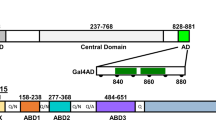Abstract
It is widely believed that dimerization is a requirement for the yeast transcriptional activator GCN4 to recognize its specific DNA target sites. We used the basic region (226-252) of the yeast transcriptional activator GCN4, as both a monomeric peptide and a disulfide-linked dimer to investigate the interaction of the peptides with the DNA target sites AP-1 and CRE. CD and ITC experiments indicate that although the monomeric peptide GCN4-M has a weaker affinity with the DNA relative to the disulfide-linked dimer peptide GCN4-D, it recognizes AP-1 and CRE target sites specifically.
Similar content being viewed by others
References
Kouzarides, T., Ziff, E., Leucine zippers of fos, jun and GCN4 dictate dimerization specificity and thereby control DNA binding, Nature (London), 1989, 340: 568.
Turner, R., Tjian, R., Leucine repeats and an adjacent DNA binding domain mediate the formation of functional cFos-cJun heterodimers, Science, 1989, 243: 1688.
O’shea, E. K., Rntkowski, R., Kim, P. S., Evidence that the leucine zipper is a coiled coil, Science, 1989, 243: 538.
Vinson, C. R., Sigler, P. B., Mcknight, S. L., Scissors-grip model for DNA recognition by a family of leucine zipper proteins, Science, 1989, 246: 911.
Hope, I. A., Struhl, K., Functional dissection of a eukaryotic transcriptional activator protein, GCN4 of yeast, Cell, 1986, 46: 885.
Ellenberger, T. E., Brandle, C. J., Struchl, K. et al., The GCN4 basic region leucine zipper binds DNA as a dimer of uninterrupted alpha helices: crystal structure of the protein-DNA complex, Cell, 1992, 71: 1223.
Konig, P., Richmond, T. J., The X-ray structure of the GCN4-bZIP bound to ATF/CREB site DNA shows the complex depends on DNA flexibility, J. Mol. Biol., 1993, 233: 139.
Weiss, M. A., Ellenberger, T., Wobbe, C. R. et al., Folding transition in the DNA-binding domain of GCN4 on specific binding to DNA, Nature, 1990, 347: 575.
Berger, C., Piubelli, L., Haditsch, U. et al., Diffusion-controlled DNA recognition by an unfolded, monomeric bZIP transcription factor, FEBS Letters, 1998, 425: 14.
Metallo, S. J., Schepartz, A., Certain bZIP peptides bind DNA sequentially as monomers and dimerize on the DNA, Nature Struct. Biol., 1997, 4: 115.
Berger, C., Jelisarov, I., Bosshard, H. R., Coupled folding and site-specific binding of the GCN4-bZIP transcription factor to the AP-1 and ATF/CREB DNA sites studied by microcalorimetry, Biochemistry, 1996, 35: 14984.
Talanian, R. V., McKnight, C. J., Kim, P. S., Sequence-specific DNA binding by a short peptide dimer, Science, 1990, 249: 769.
Knorr, R., Trzeciak, A., Bannwarth, W. et al., New coupling reagents in peptide chemistry, Tetrahedron. Lett., 1989, 30: 1927.
Tarn, J. P., Heath, W. F., Marifield, R. B., Mechanisms for the removal of benzyl protecting groups in synthetic peptides by trifluoromethanesulfonic acid-trifluoroacetic acid-bimethyl sulfide, J. Am. Chem. Soc., 1986, 108: 5242.
Canter, C. R., Warshaw, M., Shpiro, H., Oligonucleotide interactions, 3. Circular dichroism studies of the conformation of deoxyoligonucleotides, Biopolymer, 1970, 9: 1059.
Freire, E., Mayorga, O. L., Straume, M., Isothermal titration, Anal. Chem., 1990, 62L: 950A.
Talanian, R. V., McKnight, C. J., Rutkowski, R. et al., Minimum length of a sequence-specific DNA binding peptide, Biochemistry, 1992, 31: 6871.
Murphy, K. P., Freire, E., Thermodynamics of structural stability and cooperative folding behavior in proteins, Adv. Protein Chem., 1992, 43: 313.
Spolar, R. S., Record, M. T. Jr., Coupling of local folding to site-specific binding of protein to DNA, Science, 1994, 263: 777.
Author information
Authors and Affiliations
Corresponding author
Rights and permissions
About this article
Cite this article
Cao, W., Liu, L., Lai, L. et al. Molecular recognition: monomer of the yeast transcriptional activator GCN4 recognizes its dimer DNA binding target sites specifically. Sc. China Ser. B-Chem. 43, 466–476 (2000). https://doi.org/10.1007/BF02969492
Received:
Issue Date:
DOI: https://doi.org/10.1007/BF02969492




